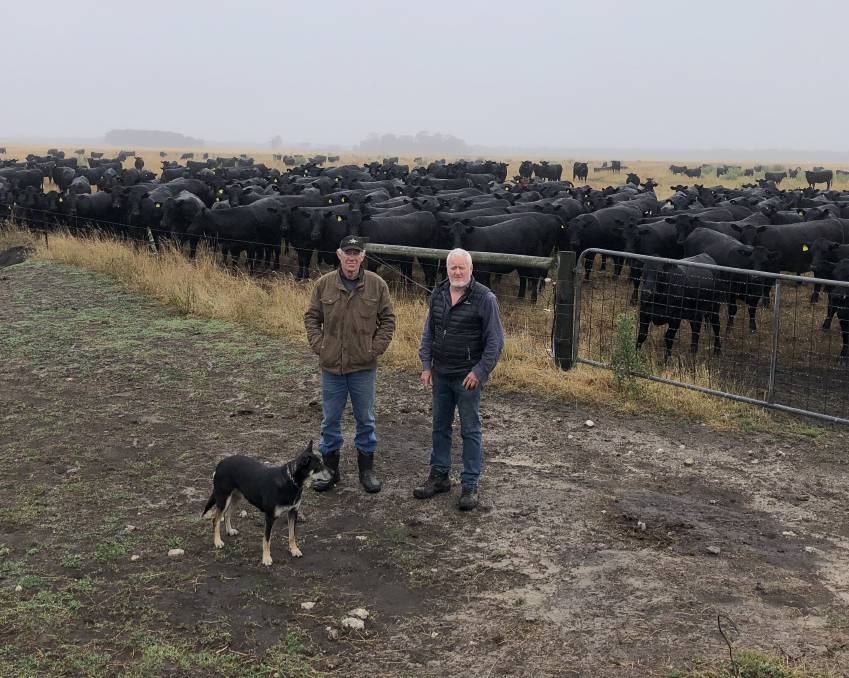Article and photos by Kylie Nicholls, Stock and Land.
GENETICS: Main picture, Doug Smith and Steve Brain, Boona, Mumbannar, Vic, with some of their 480 heifers joined via artificial insemination in October to high-performing Te Mania sires, Pheasantry and Quest.
SELECTING industry-leading genetics combined with time controlled grazing is helping the Brain family achieve significant gains in the productivity of their Angus herd.
Steve and Sue Brain, along with assistant manager Doug Smith and his son Harry, currently run 1050 pure Angus breeding cows across their 1077-hectare property (930ha grazed), Boona, at Mumbannar in south-west Victoria.
During the past three years Boona has increased their turnoff from an average of about 550 kilograms of beef per ha up to 650kg /ha of beef produced and Mr Brain believes this figure can be further improved.
“Focusing on high-performing genetics and carefully managing our grazing has allowed us to gradually boost our production per ha,” Mr Brain said.
“A figure of 1000kg of beef/ha sounds nice but I think would be very difficult to achieve with a self-replacing breeding herd, but we’ll continue to try and improve our pasture production efficiencies.
“Stocking rate is also a key performance indicator, we aim to achieve an average of 18 Dry Sheep Equivalents per ha and up to about 28 DSE/ha in the spring before the steers move out of the system.”
Since purchasing the property in the early 1980s, the Brain family have concentrated their efforts on breeding a fertile, easy-calving Angus cow which will produce steers reaching a target weight of 480 to 500kg at 13 to 15 months of age, suitable for the Rangers Valley feedlot long-fed specifications.
Boona have been long-term clients of the Gubbins family’s Te Mania stud, Mortlake, Vic, and are one of the original members of the innovative Team Te Mania program.
“Being part of the Team Te Mania program has been very beneficial,” Mr Brain said.
“The sharing of knowledge and information, catching up with other members on their farms and attending workshops run by Te Mania is vital, we’re always learning.”
Proven sires
Mr Brain employs a strict criteria for his bull selection, using a combination of visual assessment and estimated breeding values (EBVs).
Significant emphasis is placed on structural soundness, fertility, growth and carcase quality traits including marbling and eye muscle area.
“Sue and I went to Japan about 28 years ago, and while we were there we met with meat industry representatives and looked at the Aussie beef campaign,” Mr Brain said.
“I realised the importance of marbling and meat quality and we came back and started selecting highly for marbling in our cattle as I thought that was what the market was going to demand.”
They currently lease about 30 bulls each year from Te Mania as well as carrying out an extensive artificial insemination (AI) program with their heifers.
“All the bulls we lease are in the top 10 per cent of industry EBVs,” Mr Brain said.
“Because there is such a wide range of genetics available from Te Mania, you can tailor your bull selection to meet your breeding objectives.
“For example, we are always trying to select the higher marbling sires and for the past two years have used a young sire, Te Mania Pheasantry, in our AI program.
“He is in the top 1pc of the industry for intramuscular fat, as well as being easy-calving, with a low birth weight, short gestation, and good growth and carcase weight.
“That’s one advantage of being a member of Team Te Mania as we have access to high-performing bulls at a reasonable cost.”
INTENSIVE: Time-controlled grazing is used to maximise steer and heifer growth rates.
This selection focus has already paid off, with Boona winning several awards for their carcase results through Rangers Valley, including achieving a high marbling score of nine.
“The cattle have been performing very well and I think that’s the genetics coming through and using Te Mania Pheasantry is going to take it up another level, it’s very exciting,” Mr Brain said.
“In a self-replacing herd you want to have fertility, calving ease and good growth rates.
“We like the bulls to be a minimum +120 for 600-day growth and that’s across both heifer and cow bulls
“The heifer bulls we use are under four for birth weight and anything up to five or six birth weight for cows.
“A short gestation length is also important, last year 80pc of Te Mania Pheasantry’s calves were on the ground before the calving date so that early gestation trait is definitely coming through.”
The cows are joined for eight weeks from early November to start calving in mid-August, maximising the spring flush of feed.
A fixed time AI program is carried out two weeks earlier than the main herd mating for ease of management, with about 480 to 500 heifers annually joined.
Pregnancy testing is carried out in January with both early and late calvers identified in the heifer portion. Conception rates average about 93pc in the heifers and 95pc in the mature cows.
“Last year we achieved conception rates of 92pc in the heifers with 55pc in-calf through AI, which was a very good result overall,” Mr Brain said.
“But we have fine-tuned the timing of the program this year to hopefully boost the AI conception rates.”
Thriving pastures
According to Mr Brain, time-controlled grazing and careful pasture monitoring play a key role in improving steer and heifer growth rates.
According to Mr Brain, time-controlled grazing and careful pasture monitoring play a key role in improving steer and heifer growth rates.
The farm comprises a diverse mix of perennial pastures including ryegrass, cocksfoot, Holdfast phalaris, lucerne, chicory and various subclovers.
They also have 160ha of high-performance irrigated pastures, including fescue, white clover and ryegrass.
“We have been time-controlled grazing for more than 10 years and are really seeing the benefits,” Mr Brain said.
“Our pastures are improving all the time and the animals are always fully fed.
“In the past few years we’ve also had the opportunity to lock up several paddocks and let the plants go to seed.
“This has been really important to develop bigger root systems underground, better water holding capacity and has given the system more resilience.
“It’s amazing how much more productive that paddock is in the following year.”
Strategic fertiliser applications are also boosting soil health and pasture growth.
Mobbing up
The herd is set stocked during calving and once calving has finished, they are run in large mobs of more than 300 head and rotated through the paddocks.
“We start mobbing up straight after calving to help with the rotation during spring and keep on top of the pasture growth,” he said.
“It’s also a way of getting all the calves trained as well, if they are getting moved every three or four days, they get very used to going to different paddocks and putting their heads down and grazing straight away.
“It’s a bit like a dairy herd, the more you handle them, the better they are to deal with and they look forward to being moved.
“Time-controlled grazing has had a huge benefit on animal behaviour and performance.”
The calves are yard-weaned in early January before being rotated through the irrigated pastures.
“We’ll use the irrigated pastures through the summer and autumn but once we have built a feed wedge for winter, the weaners will move onto the dryland pastures,” Mr Brain said.
“The dryland pastures are better for steer and heifer growth through the winter.
“I think you get more pasture mineralisation and the nutrition is better for the younger stock.
“Then we drop all the fences in the pivots and let the cows calve in there.”
During winter, three rotations comprising five mobs of cattle are run with the weaner steers leading the way. The speed of the rotation depends on the time of the year and grass growth.
Typically each paddock receives a rest period of 34 days during winter and about 18 days in spring and early summer.
“We aim to have the best feed in front of the steers. They go in at 2500 to 3000kg of dry matter/ha and move out of the paddock at 1000 to 1200kgDM/ha,” he said.
The steers are also supplemented with hay at about 1kg/hd/day through the winter for roughage and to assist with rumen function.
Mr Brain will start selling the steers from October onwards once they hit the 500kg mark, with the majority going direct under contract to Rangers Valley feedlot, Glen Innes, NSW. They aim to have them all sold before Christmas.
About 350 heifers calve down each year, with the remainder sold at the Team Te Mania female sale in March as pregnancy-tested-in-calf heifers. Mr Brain will also offer 120 to 150 PTIC cows.
For the full article and photos click here

